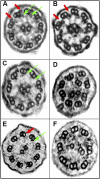Primary ciliary dyskinesia. Recent advances in diagnostics, genetics, and characterization of clinical disease
- PMID: 23796196
- PMCID: PMC3826280
- DOI: 10.1164/rccm.201301-0059CI
Primary ciliary dyskinesia. Recent advances in diagnostics, genetics, and characterization of clinical disease
Abstract
Primary ciliary dyskinesia (PCD) is a genetically heterogeneous recessive disorder of motile cilia that leads to oto-sino-pulmonary diseases and organ laterality defects in approximately 50% of cases. The estimated incidence of PCD is approximately 1 per 15,000 births, but the prevalence of PCD is difficult to determine, primarily because of limitations in diagnostic methods that focus on testing ciliary ultrastructure and function. Diagnostic capabilities have recently benefitted from (1) documentation of low nasal nitric oxide production in PCD and (2) discovery of biallelic mutations in multiple PCD-causing genes. The use of these complementary diagnostic approaches shows that at least 30% of patients with PCD have normal ciliary ultrastructure. More accurate identification of patients with PCD has also allowed definition of a strong clinical phenotype, which includes neonatal respiratory distress in >80% of cases, daily nasal congestion and wet cough starting soon after birth, and early development of recurrent/chronic middle-ear and sinus disease. Recent studies, using advanced imaging and pulmonary physiologic assessments, clearly demonstrate early onset of lung disease in PCD, with abnormal air flow mechanics by age 6-8 years that is similar to cystic fibrosis, and age-dependent onset of bronchiectasis. The treatment of PCD is not standardized, and there are no validated PCD-specific therapies. Most patients with PCD receive suboptimal management, which should include airway clearance, regular surveillance of pulmonary function and respiratory microbiology, and use of antibiotics targeted to pathogens. The PCD Foundation is developing a network of clinical centers, which should improve diagnosis and management of PCD.
Figures


References
-
- Zariwala MA, Knowles MR, Omran H. Genetic defects in ciliary structure and function. Annu Rev Physiol. 2007;69:423–450. - PubMed
-
- Barbato A, Frischer T, Kuehni CE, Snijders D, Azevedo I, Baktai G, Bartoloni L, Eber E, Escribano A, Haarman E, et al. Primary ciliary dyskinesia: a consensus statement on diagnostic and treatment approaches in children. Eur Respir J. 2009;34:1264–1276. - PubMed
-
- Kartagener M. Zur pathogenese der bronkiectasien. Bronkiectasien bei situs viscerum inversus. Beitr Klin Tuberk Spezif Tuberkuloseforsch. 1933;83:489–501.
Publication types
MeSH terms
Grants and funding
LinkOut - more resources
Full Text Sources
Other Literature Sources

